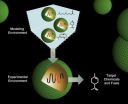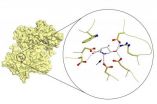(Press-News.org) All life evolved from a single-celled universal common ancestor, and at various times in Earth history, single-celled organisms threw their lot in with each other to become larger and multicellular, resulting, for instance, in the riotous diversity of animals. However, fossil evidence of these major evolutionary transitions is extremely rare.
The fossils, reported this week in Science, preserve stages in the life cycle of an amoeba-like organism dividing in asexual cycles, first to produce two cells, then four, eight, 16, 32 and so on, ultimately resulting in hundreds of thousands of spore-like cells that were then released to start the cycle over again. The pattern of cell division is so similar to the early stages of animal (including human) embryology that until now they were thought to represent the embryos of the earliest animals.
The researchers studied the microscopic fossils using high energy X-rays at the Swiss Light Source in Switzerland, revealing the organisation of the cells within their protective cyst walls. The organisms should not have been fossilized – they were just gooey clusters of cells – but they were buried in sediments rich in phosphate that impregnated the cell walls and turned them to stone.
Lead author Therese Huldtgren said: "The fossils are so amazing that even their nuclei have been preserved."
Co-author Dr John Cunningham said: "We used a particle accelerator called a synchrotron as our X-ray source. It allowed us to make a perfect computer model of the fossil that we could cut up in any way that we wanted, but without damaging the fossil in any way. We would never have been able to study the fossils otherwise!"
This X-ray microscopy revealed that the fossils had features that multicellular embryos do not, and this led the researchers to the conclusion that the fossils were neither animals nor embryos but rather the reproductive spore bodies of single-celled ancestors of animals.
Professor Philip Donoghue said: "We were very surprised by our results – we've been convinced for so long that these fossils represented the embryos of the earliest animals – much of what has been written about the fossils for the last ten years is flat wrong. Our colleagues are not going to like the result."
Professor Stefan Bengtson said: "These fossils force us to rethink our ideas of how animals learned to make large bodies out of cells."
###
This release is available in Swedish.The research was funded by the Natural Environment Research Council, the Swedish Research Council, the Paul Scherrer Institut, Ministry of Science and Technology of China, National Natural Science Foundation of China, and EU FP7.
Notes to editors
Paper
Huldtgren, T., Cunningham, J. A., Yin, C., Stampanoni, M., Marone, F., Donoghue, P. C. J. and Bengtson, S. 2011. 'Fossilized nuclei and germination structures identify Ediacaran "animal embryos" as encysting protists' in Science 334.
Therese Huldtgren is a doctoral student at the Department of Palaeozoology, Swedish Museum of Natural History, and Stockholm University, Stockholm, Sweden.
Dr John Cunningham is a Research Associate at the School of Earth Sciences, University of Bristol, UK.
Professor Chongyu Yin is a Researcher at the Institute of Geology, Chinese Academy of Geological Sciences, Beijing, China.
Professor Marco Stampanoni is Head of X-ray Tomography at the Paul Scherrer Institute, Villigen, Switzerland and Assistant Professor for X-ray Microscopy at the Department for Information Technology and Electrical Engineering of ETH Zürich, and Institute of Biomedical Engineering of the University of Zürich and ETH Zürich.
Dr Federica Marone is a beamline scientist at the Paul Scherrer Institute, Villigen, Switzerland.
Professor Philip Donoghue is Professor of Palaeobiology in the School of Earth Sciences, University of Bristol, UK
Professor Stefan Bengtson is Professor of Palaeozoology, Swedish Museum of Natural History, Stockholm, Sweden
Issued by the Public Relations Office, Communications Division, University of Bristol, tel: 0117-928-8896, email: hannah.johnson@bristol.ac.uk
One of the most extensive US-based dog training companies, Canine Trade Group, is proud to introduce a new 300 acre training facility in Dover, Delaware where its Professional Dog Trainer's Course will be held. Owned and operated by world-renowned dog trainer John Van Olden, Canine Trade Group offers customized training programs for dog trainers and their dogs. The new Dover Training Facility boasts a private, 20-run climate controlled kennel, an abundance of training field space, as well as accommodations such as on-site lodging or a country inn located less than a mile ...
Researchers at the Johns Hopkins Malaria Research Institute have demonstrated that the Anopheles mosquito's innate immune system could be genetically engineered to block the transmission of malaria-causing parasites to humans. In addition, they showed that the genetic modification had limited impact on the mosquito's fitness under laboratory conditions. The researchers' findings are published December 22nd in the Open Access journal PLoS Pathogens.
In this study, Dimopoulos and his team genetically engineered Anopheles mosquitoes to produce higher than normal levels ...
A research team led by Glenn Rall at the Fox Chase Cancer Center in Philadelphia, PA developed a novel mouse model to show that a fatal central nervous system (CNS) disease can be caused by a pathogen that does not replicate in the CNS. The results of this new study are published December 22nd in the Open Access journal PLoS Pathogens.
The authors found that the immune response induced in response to a peripheral viral infection can be "mis-recruited" to the brain, where these activated immune cells can then lead to inflammation-induced neuropathology and disease. While ...
The computer assisted design (CAD) tools that made it possible to fabricate integrated circuits with millions of transistors may soon be coming to the biological sciences. Researchers at the U.S. Department of Energy (DOE)'s Joint BioEnergy Institute (JBEI) have developed CAD-type models and simulations for RNA molecules that make it possible to engineer biological components or "RNA devices" for controlling genetic expression in microbes. This holds enormous potential for microbial-based sustainable production of advanced biofuels, biodegradable plastics, therapeutic ...
KANSAS CITY, MO -- Life is complicated enough, so you can forgive the pioneers of DNA biology for glossing over transcriptional elongation control by RNA polymerase II, the quick and seemingly bulletproof penultimate step in the process that copies the information encoded in our DNA into protein-making instructions carried by messenger RNA.
In a new report appearing in the Dec. 23, 2011, issue of Molecular Cell, researchers at the Stowers Institute for Medical Research add not just a new layer, but a whole new dimension to transcriptional elongation control with evidence ...
Chiropractic Internet marketing strategist and social media expert, Dr. Matthew Loop, has announced he'll continue to show DCs how to create an overwhelming presence on Facebook, which can easily net doctors an extra 20-30 new patients per month just from the social network. Dr. Loop's been helping fellow chiropractors master social media marketing since 2005-2006, which gives him an experience-based edge over other industry consultants.
He's garnered a well deserved reputation as the "go-to" guy for chiropractors that want to dramatically improve their new ...
December 22, 2011 – Smoking is a well-known risk factor for lung cancer, but nearly 25% of all lung cancer patients have never smoked. In a study published online today in Genome Research (www.genome.org), researchers have identified a previously unknown gene fusion event that could explain a significant proportion of lung cancer cases in never-smokers, and might serve as a target for new therapies.
Recent strides have been made to identify gene mutation events driving cases of lung adenocarcinoma in never-smokers, but the underlying genetic events leading to these lung ...
In eukaryotes – the group of organisms that include humans – a key to survival is the ability of certain proteins to quickly and accurately repair genetic errors that occur when DNA is replicated to make new cells.
In a paper published in the December 23, 2011 issue of the journal Science, researchers at the Ludwig Institute for Cancer Research and the University of California, San Diego School of Medicine have solved part of the mystery of how these proteins do their job, a process called DNA mismatch repair (MMR).
"One of the major questions in MMR is how MMR proteins ...
AMHERST, Mass. – A research team led by biochemist Scott Garman at the University of Massachusetts Amherst has discovered a key interaction at the heart of a promising new treatment for a rare childhood metabolic disorder known as Fabry disease. The discovery will help understanding of other protein-folding disorders such as Alzheimer's, Parkinson's and Huntington's diseases, as well. Findings are featured as the cover story in the current issue of Chemistry & Biology.
People born with Fabry disease have a faulty copy of a single gene that codes for the alpha-galactosidase ...
Research by University of Tennessee, Knoxville, faculty has discovered that bacteria's move from sea to land may have occurred much later than thought. It also has revealed that the bacteria may be especially useful in bioenergy research.
Igor Jouline, UT-Oak Ridge National Laboratory joint faculty professor of microbiology and researcher at ORNL's Joint Institute for Computational Sciences, performed a genome sequence analysis of the soil bacteria Azospirillum, a species' whose forbearers made the sea-to-land move. The analysis indicates the shift may have occurred ...




